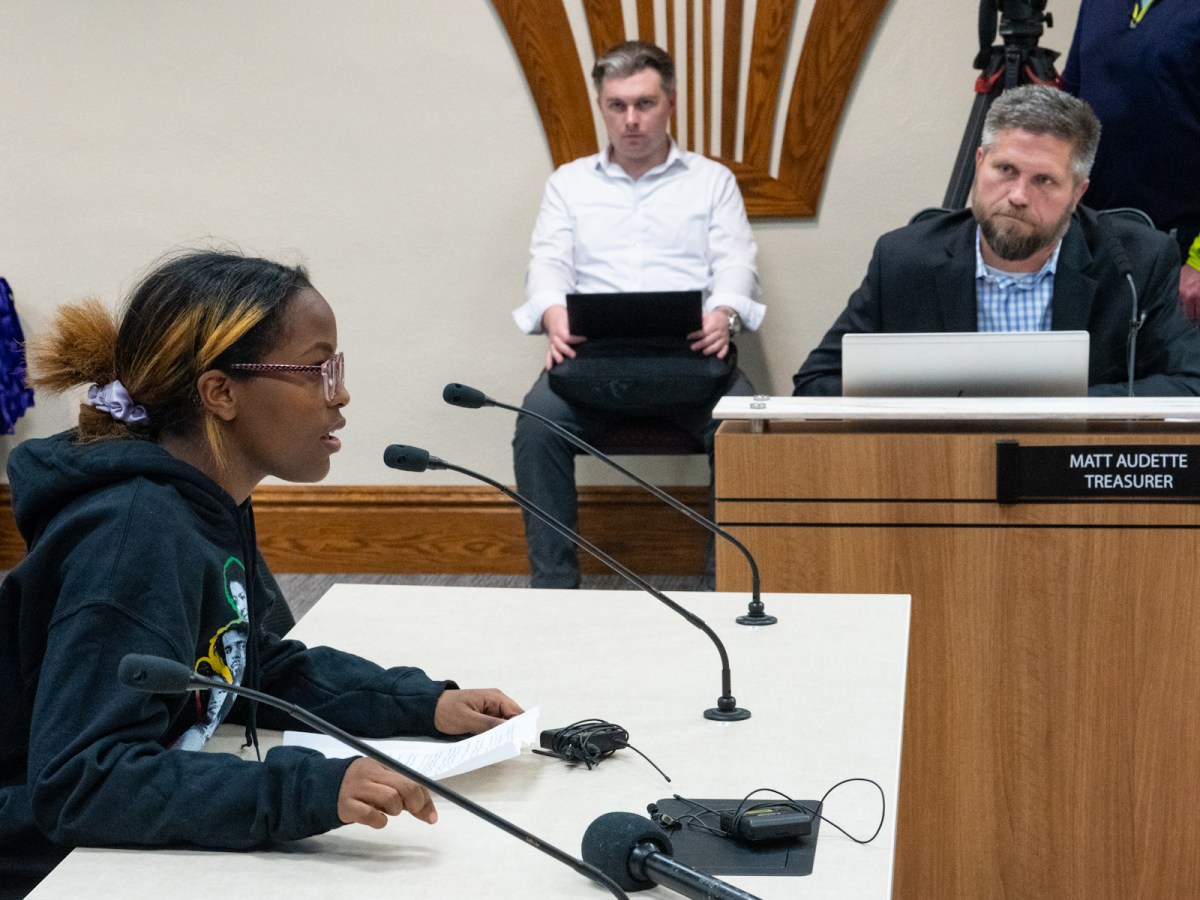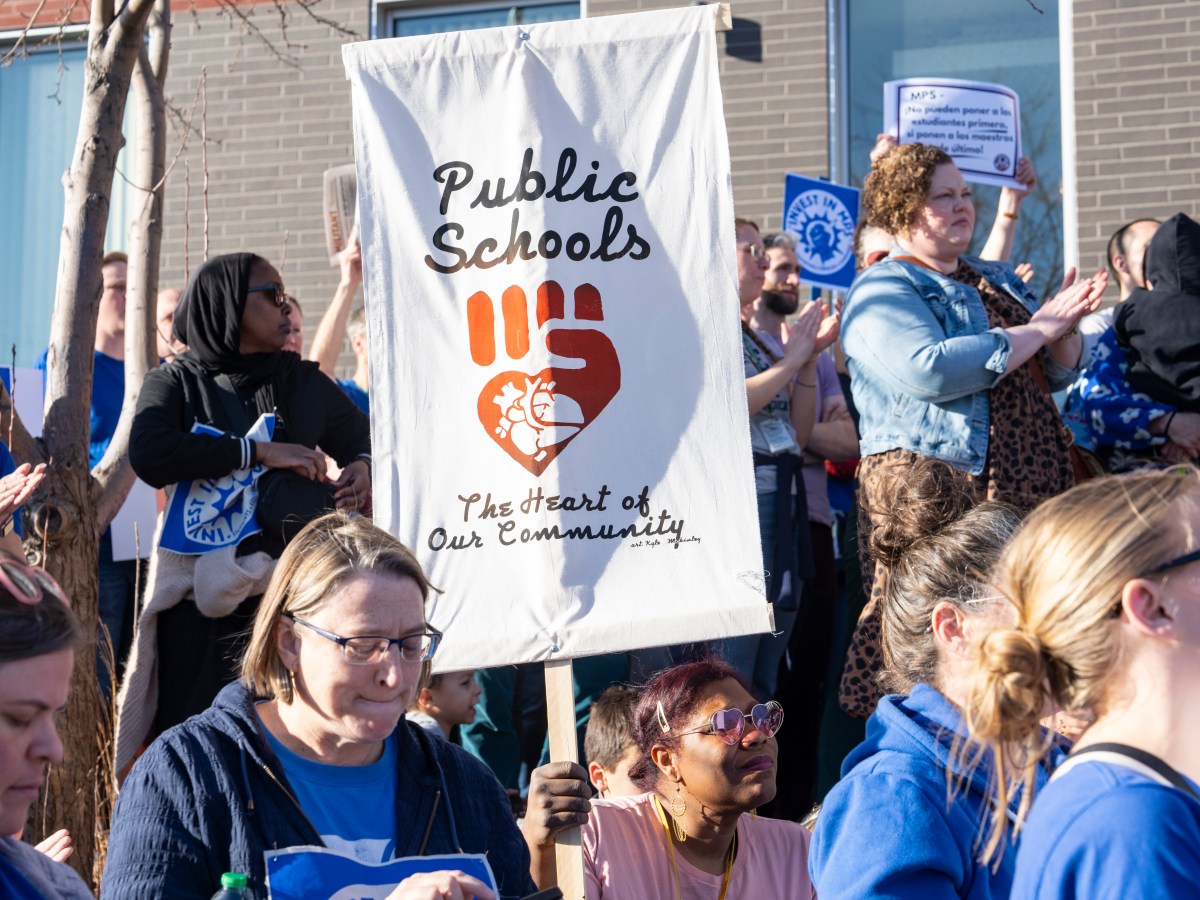An all-white school board voted Tuesday night to remove LGBTQ and Puerto Rican flags from a teacher’s classroom at Worthington High School, where nearly two-thirds of students are Latino.
The vote followed months of school board discussion, after a parent complained about a Pride flag in September.
“I felt stripped of my own identities,” said the teacher, José Morales Collazo, recalling when he first heard about the parent’s complaint.
Worthington’s demographics have changed quickly in recent decades as new immigrants have found a home in the southwestern Minnesota town. Many work for the JBS pork plant, the town’s largest employer. Three in four residents were listed as white in the 2000 census; in 2022, 41 percent were Hispanic or Latino. That demographic change has come even faster to the schools.
Erin Schutte Wadzinski, an immigration lawyer who serves on the school board, said that Worthington has not fully integrated its changing population.
“There remain divides between newcomers and the traditionally conservative-leaning whites whose ancestors settled on the region’s farmland generations ago, although slowly more intermingling is occurring,” she said in an email.
Despite the changing demographics, leadership in the school district looks much the same as it did 20 years ago. The superintendent and all of the school board members are white. So are about 94 percent of district teachers, according to state data.
Morales Collazo said that in his four years as a teacher at Worthington High School, many of his students have told him his classroom was the one place they could be themselves. The dustup over the flags reflects Worthington Public Schools’ failure to adequately represent its students, he said.
“You have people in power who do not understand the diversity they live in,” he said.
‘Not everybody is comfortable’
The vote to remove the flags, first reported by the Worthington Globe, followed months of discussion, controversy, public hearings, and student protest.
Superintendent John Landgaard said in an interview Friday that while the school board had ultimate authority over the matter, it was important for the school walls to remain impartial.
“Schools are a neutral place,” he said. That’s why he advocated for the flags to come down, he said. “Items that can be perceived as controversial are not necessarily neutral and don’t belong on school walls.”
Though the original parent complaint focused on the LGBTQ Pride flag, the school board voted to remove Morales Collazo’s Puerto Rican flag as well.
At Tuesday’s meeting, school Board Member Steve Schnieder said he believed the only appropriate flags to display in a school building were the U.S. and Minnesota flags.
“You can be proud of where you live, but you also came here, and you’re going to school here and you’re part of our state of Minnesota, and you should also be proud to be here,” he said.
Superintendent John Landgaard, who has held his position since 2003, said the district had precedent for not allowing other kinds of flags, such as Black Lives Matter flags.
“They celebrate Black Lives Month, but it’s not with a flag,” he said at Tuesday’s meeting. “So there is a history there.”
Several speakers stressed that the flags had caused some people to feel uncomfortable.
“It’s items that bring up a disruption in the school building,” Landgaard said.
“We have a complaint about a particular flag, and not everybody is comfortable,” said school Board Member Lori Dudley.
Schutte Wadzinski pushed back.
“It may make some students uncomfortable, but I would argue that it makes many, many more students feel comfortable in the classroom,” she said. “I think it’s imperative that we take actions as a school district that are going to encourage staff to stay here.”
Some of her colleagues agreed with the need to make students feel comfortable, but suggested that flags were not an appropriate way to express it. Perhaps teachers could wear lapel pins, or the district could create support groups, Schnieder suggested.
But not everyone agreed the district needed to do more in this regard.
“Why does it take whatever Pride flag or whatever to make you feel welcome?” asked Adam Blume, the board vice chair. “I think teachers, and I think administration do a pretty good job at that. And I think that we sit here as a board and do a good job of that.”
Blume brought forward a motion to remove the flags. Only Schutte Wadzinski voted no; two other board members were absent. The board chair, Joel Lorenz, did not respond to a Sahan Journal interview request.
“I’m sure there’s going to be people upset with this decision tonight, but deal with it,” Blume said. “Not everybody’s going to be happy. I’m ready to put it to bed. I want the controversy over.”
Creating a haven in a high school
Morales Collazo arrived in Worthington four years ago. His future husband had an agricultural job in the area; Morales Collazo found a job teaching science at the high school. A Puerto Rico native, Morales Collazo had recently completed his doctorate in education at the State University of New York at Binghamton.
Jodi Hansen, the head of the science department at Worthington High School and the president of the local teachers union, participated in Morales Collazo’s Zoom interview.
“We looked at his application and we couldn’t figure out why someone with a Ph.D. would be interested in coming to teach in Worthington,” she said. She recalled being impressed with his background in getting underrepresented students interested in STEM. “He was everything we were looking for. Everything.”
When Morales Collazo arrived in Worthington, he loved serving a diverse community with many students of color. In addition to teaching science, he also signed up to coach robotics and esports. But he soon realized that the school administration had not kept up with the changing student demographics. He could count the school’s Latino teachers on one hand.
“I realized that although it’s a very diverse school, there’s not very diverse practices,” he said. “I was seeing very traditional schooling experiences that you would see in any other small town.”
For example, when he arrived, the school did not celebrate Hispanic Heritage Month, despite its high Latino population. Morales Collazo adorned the halls with papel picado, a traditional Mexican decorative paper, to mark the month. He also started a cultural advocacy group, where he found students excited to share their cultures. He said students were drawn to his ability to connect with their culture and language.
“I have students who show up to my classroom and they don’t show up to anything else,” he said.
“José has been able to reach out to kids who have a harder time finding where they belong,” Hansen said. “He helps them to find a place where they do truly belong.”
But, Morales Collazo said, he kept running into barriers.

A banner for Black History Month was torn down. And when he applied to make the cultural advocacy group an official student club, the district denied his request. That designation would have allowed Morales Collazo to fundraise, rather than spending his own money on the group.
Landgaard, the superintendent, told Morales Collazo that the district was not adding more clubs, citing calendar and budget concerns, in an email Morales Collazo provided to Sahan Journal.
“We currently have many opportunities for students to participate in clubs or activities and do not add them late in the year,” Landgaard wrote.
Landgaard said Friday that there was a protocol for forming new clubs and he could not recall whether Morales Collazo had followed it. He said the Nobles County Integration Collaborative serves diverse students, including through some clubs. The collaborative also provides cultural food and music activities, though usually not at the high school.
Students in the LGBTQ community had asked Morales Collazo to create a space for them to celebrate their culture too. They hoped to celebrate Pride Month in April, since school is not in session in June, when the occasion is traditionally honored. Morales Collazo emailed Josh Noble, the director of instruction, to request permission. But Noble shot him down without explanation, according to an email Morales Collazo provided to Sahan Journal.
“I think we should take a break for a bit so let’s not plan to move Pride Month into April here at WHS,” Noble wrote.
Landgaard said he was not familiar with the Pride Month request.
Morales Collazo grew disillusioned with trying to make change in the broader school community.
“Seeing that I was unable to do anything in the school environment to promote equity and inclusion, then I took it to my classroom,” he said. “I can at least use my space to create that haven.”
That’s when he decided to put up flags in his classroom. He first displayed the Puerto Rican flag last year; this year, he added a Pride banner with the words “everyone is welcome.”
But it was just weeks into the school year that a parent complained. Morales Collazo recalled sobbing in the principal’s office when he first heard the news. He’s received plenty of support from students and staff, he said, but they are not the ones making decisions.
“I have lost all my passion, all my desire to do anything,” he said.
When the flag controversy began, he was already interviewing for a professor job back in New York State. At the end of this school year, Morales Collazo will leave Worthington High School to become an assistant professor of science education at the State University of New York in Brockport.
“Losing him is a big blow,” Hansen said.
His students have found it difficult to understand why he is leaving, he said. One cried. His juniors made him promise to come back for their graduation.
RELATED STORIES
Some students staged a protest in support of his flags this fall, wearing flags representing different countries and LGBTQ pride. They gathered over 100 petition signatures. But Hansen said that protest resulted in some severe bullying, leaving most students afraid to speak out.
School board members and administrators keep asking why English language learners are failing, Morales Collazo said. “They don’t see this heavily impacts their performance, because they don’t want to be in a place that doesn’t accept them,” he said.
He reflected on how students lit up when he decorated the hallways with papel picado. They thanked him for showing them representation. Administrators did not understand that, he said.
“They’ve been here over 20 years. They haven’t kept up with the diversity,” he said. “They don’t understand that when a student comes to school and sees themselves in school, they want to be there.”
But next year, Morales Collazo will not be there to help create that bridge between students and the school. And he suspects he is not alone—he’s talked to other teachers who plan to leave, too.
Echoes from history
Representative Maria Isa Perez-Vega, DFL-St. Paul, heard about Morales Collazo’s story from the LGBTQ advocacy group OutFront Minnesota. Perez-Vega, who is Puerto Rican and belongs to the Legislature’s queer caucus, felt an instant resonance in Morales Collazo’s story.
Hearing that a Puerto Rican flag was being torn down, she said, was “post-traumatic.” In 1948, the Puerto Rican legislature passed a law that made it illegal to display or even possess a Puerto Rican flag. The law, known as Ley de la Mordaza or the Gag Law, was in effect for nine years. This repression is one of the reasons the flag is such a meaningful symbol of Puerto Rican identity today, Perez-Vega explained. She noted that many people do not know this history; she hoped that the state’s recent moves to include ethnic studies in schools will help.
“There’s a lot of pride that comes with our flags, whether we are from the island or from the diaspora because it was once illegal to show pride in our identity and celebrate that,” Perez-Vega said.
Perez-Vega said she was reaching out to community members in Worthington to see how she can support them, and had requested meetings with Legislative colleagues to discuss whether a law change might be needed. Pushback on LGBTQ inclusion in schools wasn’t limited to rural communities, she noted; in St. Louis Park, a group of Somali parents recently threatened to sue the school district when they said they had not been able to opt out of LGBTQ picture books.
“We need to ensure that our queer community everywhere is safe and celebrated and know that they’re not alone, especially our queer kids,” she said.
Planting a seed
For two days after the school board vote, José Morales Collazo did not return to Worthington High School. He knows that soon, he will get an official directive to remove his flags. And soon, he’ll be gone too.
“I just hope this is a seed,” he said. Perhaps, he said, this could be the incident that brings to light the issues that have long been simmering in Worthington Public Schools. “I hope the community eventually comes together to realize they’re not as inclusive as they think they are.”
Hansen said that she had been in conversation with Education Minnesota lawyers. “We are looking at all of our options,” she said. “As a union, we absolutely will not tolerate discrimination against our members because of who they are.”
She said that staff had struggled to figure out whether they would be disciplined if they created safe spaces for students, and students had been questioning whether they belonged.
“We’ll do everything we can to continue to show students that they are welcome and valued,” she said. “In a place where we have the diversity that we do, I just can’t believe this is where we are.”
Schutte Wadzinski also said she hoped that students and staff could find ways to create safe spaces. She hoped electoral change would come, too.
“I hope the community sees the importance of civic engagement and how critical it is to elect leaders who are committed to serving the best interests of everyone in their community,” she said. “I’d love to see our school board become more representative of the district’s diverse student body.”
Morales Collazo, too, hoped that this incident would lead to change in the future. But first, he knew he had to go back to school.
He steeled himself to head back Friday, to the classroom he had made a haven. For one more day, at least, he knew his flags would still be there.






